Describe the Gross Features of Lungs.
Each lung has an apex, a base, 3 borders and 3 surfaces.
Apex that
- is blunt
- extends into the neck, an inch above the medial 1/3rd of the clavicle.
- is covered by cervical pleura and suprapleural membrane (Sibson’s fascia).
- Is related
- Anteriorly to subclavian artery and vein, and scalenus anterior muscle.
- Posteriorly to neck of 1st rib, sympathetic chain, highest intercostal vein, superior intercostal artery and ventral ramus of T1 spinal nerve.
- Laterally to scalenus medius muscle.
- Medially
- On right side to right brachiocephalic vein, right phrenic nerve, brachiocephalic artery, right vagus nerve and trachea.
- On left side to left brachiocephalic vein, left subclavian artery, left recurrent laryngeal nerve, oesophagus and thoracic duct.
Base (Diaphragmatic surface) that:
- is semilunar and concave.
- is related to the dome of the diaphragm.
- is separated from the liver by the right dome of the diaphragm on the right side.
- is separated from the fundus of the stomach and spleen by left dome of diaphragm on the left side.
Three Borders:
- Anterior border is sharp and shorter than the posterior border.
- Posterior border is thick and rounded.
- Inferior border is semilunar in shape .
*Anterior border of left side presents a concave CARDIAC NOTCH and the tongue shaped projection below the cardiac notch LINGULA.
Three Surfaces:
- Costal surface is convex and is related to ribs and intercostal muscles.
- Medial surface is divided into two parts:
- Mediastinal surface: Anterior 2/3rd of medial surface. It is related to the mediastinal structures.
- Vertebral surface: Posterior 1/3rd of medial surface. Is related to vertebral bodies and intervertebral discs

Name the fissures and lobes of right and left lungs.
Right lung has usually:
- Two fissures – Oblique and transverse/horizontal
- Three lobes – Superior, middle and inferior
Left lung has usually:
- One fissure – Oblique
- Two lobes – Superior and inferior
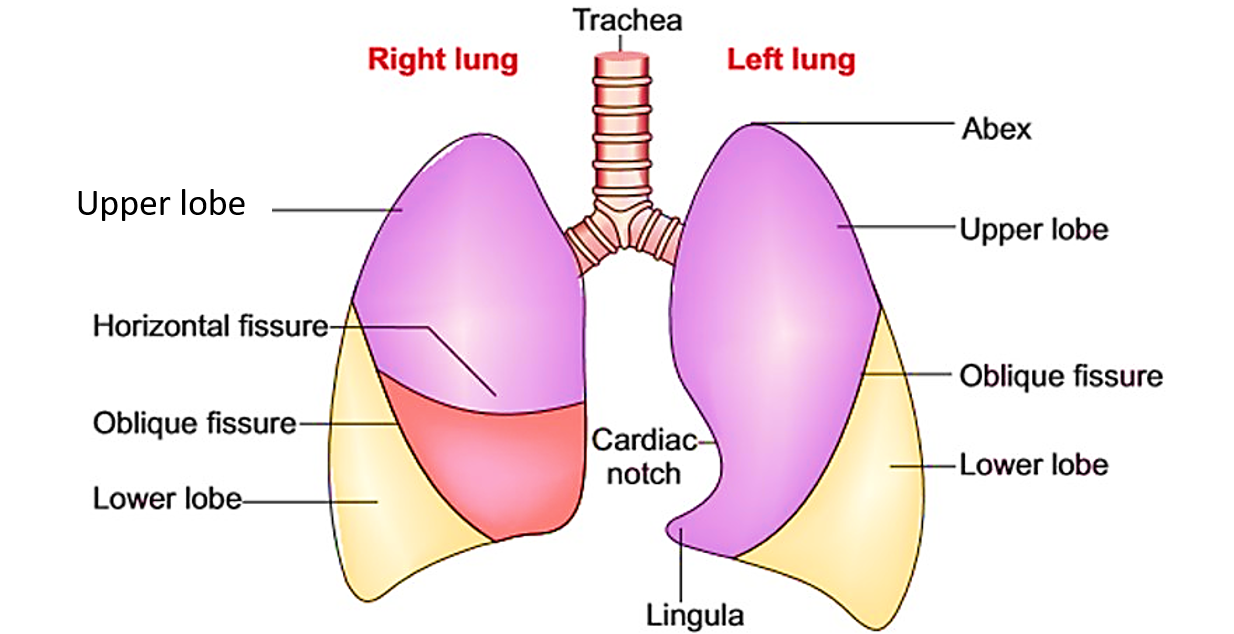
Describe the root and hilum of lungs.
Root of Lung
- Lung root consists of the structures passing to and from the hilum of the lung to the mediastinum.
- Lung roots lie opposite to T5 – T7 vertebrae.
- The structures of the lung root are embedded in the connective tissue and surrounded by extension of mediastinal pleura.
- Lung roots move downward and forward in full inspiration to allow expansion of the posterior part of the lung.
- Following structures are present in the lung root lungs:
- Principal bronchus in the left lung and eparterial and hypearterial bronchi in the right lung
- Pulmonary artery
- Superior and inferior pulmonary veins
- Bronchial arteries (one on the right side and two on the left side)
- Bronchial veins
- Nerves (anterior and posterior pulmonary plexus)
- lymphatics from the lung.
Hilum of Lung: It is that area of lung through which structures enter or leave the lung.
Enumerate the structures passing through the hilum of lungs.
Structures passing through the hilum of right and left lungs are:
From above downwards are:
Right Lung Left Lung Eparterial bronchus, Left Pulmonary artery Right Pulmonary artery Left Primary bronchus Hyparterial bronchus Inferior pulmonary vein Right Inferior pulmonary vein
From before backwards: In both right and left lungs
- Superior pulmonary vein
- Pulmonary artery
- Bronchus
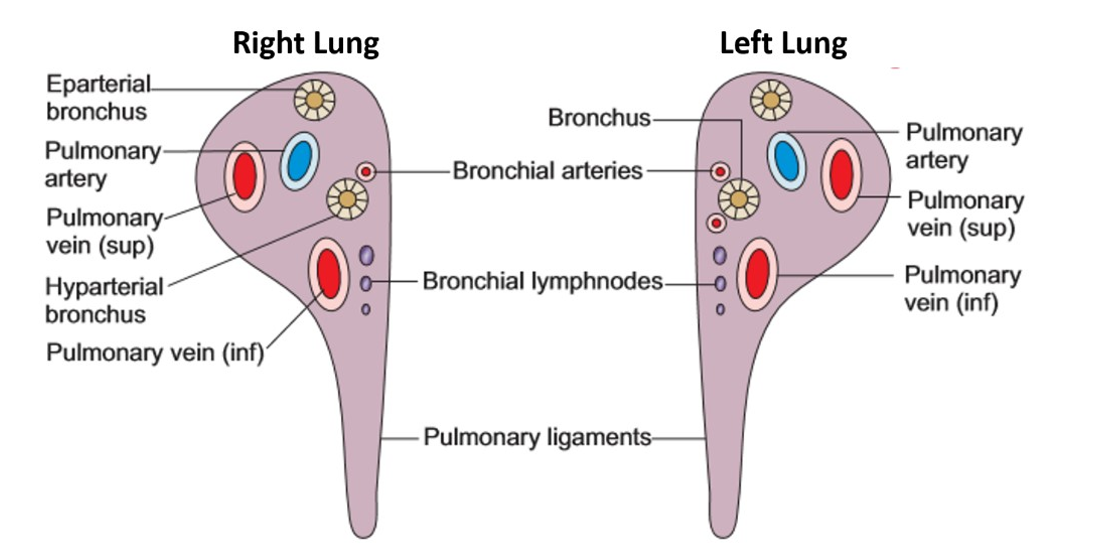
Enumerate the differences between fetal and adult lung.
| S.No. | FETAL LUNG | ADULT LUNG |
|---|---|---|
| 1 | Solid | Porus |
| 2 | Sinks in water | Float in water |
| 3 | Does not crepitate on touch | Crepitates on touch |
| 4 | Colour – pink | Colour – Grey to mottled black (due to deposition of carbon) |
| 5 | No air in alveoli | Air in alveoli |
Enumerate the differences between fetal and adult lung.
| S.No. | RIGHT LUNG | LEFT LUNG |
|---|---|---|
| 1 | Shorter | Longer |
| 2 | Wider | Longer |
| 3 | Heavier | Lighter |
| 4 | Usually has two fissures- oblique and transverse | Usually has one fissure – oblique |
| 5 | Has usually three lobes- Superior, middle and inferior | Has usually two lobes - Superior and inferior |
| 6 | Anterior border is straight | Anterior border has a concave cardiac notch |
| 7 | Base is more concave( due to liver below the diaphragm) | Base is less concave |
Draw labelled diagram showing relations of mediastinal surface of right lung.
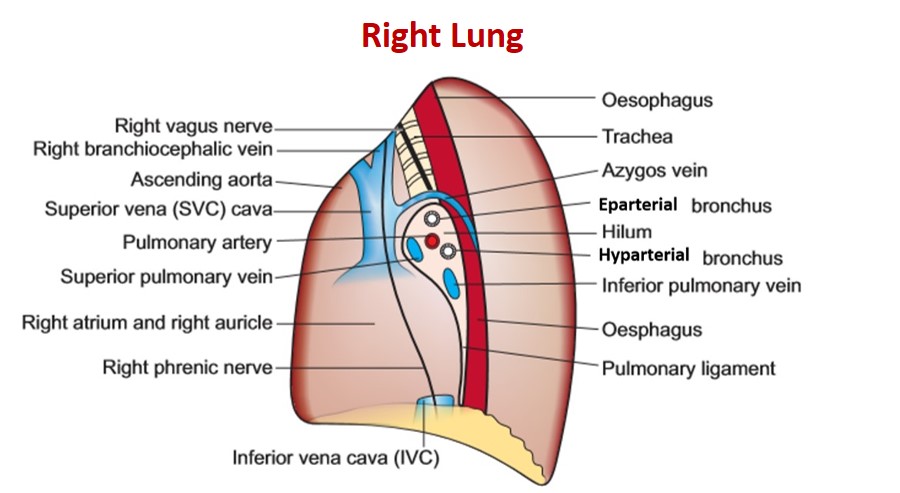
Draw labelled diagram showing relations of mediastinal surface of left lung.

Describe the bronchopulmonary segments of lungs.
Definition: Bronchopulmonary segment is a wedge-shaped self-contained functionally independent respiratory unit of lung which is aerated by tertiary or segmental bronchus.
Characteristic features:
- Each bronchopulmonary segment is pyramidal in shape with apex directed towards the hilum and base towards the surface of the lung.
- Each segment is separated from the adjacent segments by connective tissue.
- Segmental/tertiary bronchus with bronchial vessels and a branch of pulmonary artery accompanying it are central in position.
- There is little anastomosis between the arteries of adjacent segments.
- Tributaries of pulmonary vein are intersegmental running in the connective tissue septa.
- Intersegmental veins act as guide for separating the segments during surgical resection
- It is the smallest part of the lung that can be removed without affecting the adjacent regions of the lung.
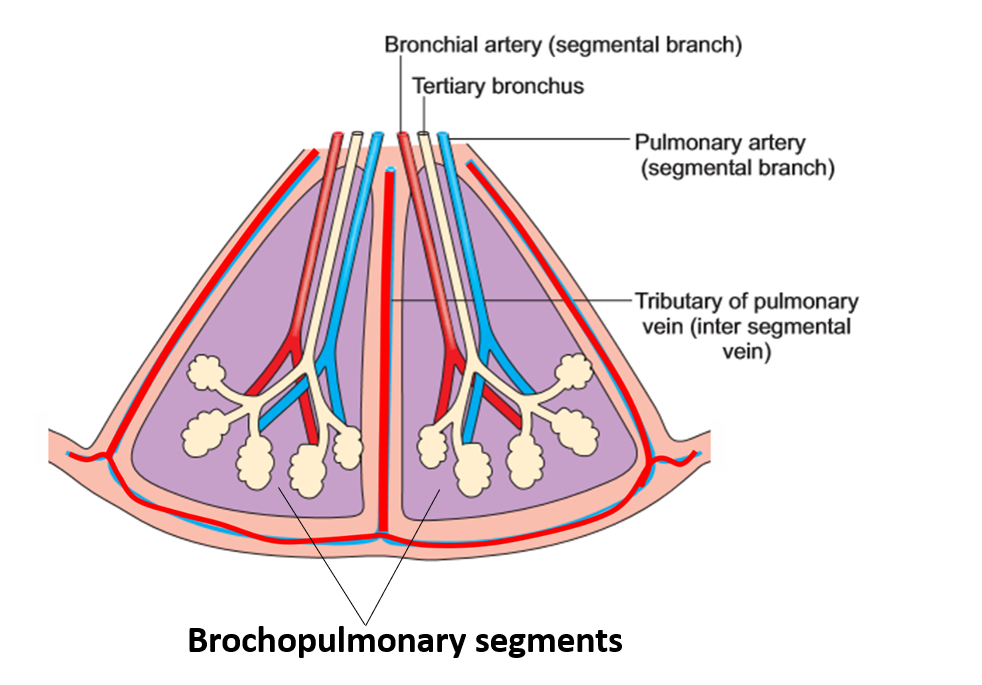
Nomenclature: There are 10 bronchopulmonary segments in each lung. Their names and location are as follows:


Clinical Significance
The connective tissue septa between the adjacent bronchopulmonary segments acts as a natural barrier and prevents spread of infection between the segments.*Carcinoma and tuberculosis break through the barrier.
The knowledge of bronchopulmonary segments helps in:
- Performing bronchoscopy.
- Correct interpretation of bronchogram.
- Understanding that abscess formation is more common in some segments viz. posterior segment of upper lobe and apical segment of the lower lobe, beacuse of their most dependent position in supine position.
- Natural drainage from the infected segment by adopting different postures e.g. for drainage of apical segment of the lower lobe the patient should be asked to lie prone with head turned to one side.
Describe the nerve supply of lungs.
Nerve supply of lungs: Lungs are supplied by autonomic nervous system. Sympathetic and parasympathetic fibers form anterior and posterior pulmonary plexus in the roots of the lungs before supplying it.
Sympathetic fibers are:
- Derived from T2 – T5 spinal segments
- Bronchodilator
- Vasomotor
- Inhibitor of secretions from the glands of bronchial tree.
*Sympathomimetic drugs such as epineherine cause bronchodilation and relieve bronchial asthma ( bronchospasm).
Parasympathetic fibers are
- Derived from the vagus nerves.
- Bronchoconstrictor
- Secretomotor
* Parasympathetic fibers also carry afferent (sensory) fibers that are sensitive to stretch and play important role in reflex control of respiration.
Describe the lymphatic drainage of lungs.
Lymph from the lungs is drained by two sets of lymph vessels.
- Superficial lymph vessels:
- Drain the peripheral lung tissue.
- Form the superficial (subpleural) plexus beneath the pleura.
- Pass around the borders and fissures of lungs to drain into the bronchopulmonary lymph nodes at the hilum.
- Deep lymph vessels:
- Drain the bronchial tree.
- Begin from the submucosa of bronhi.
- Form Deep plexus around the bronchi drain into pulmonary lymph nodes located within lungs around lobar bronchi.
- From pulmonary lymph nodes the lymph is drained into bronchoplulmonary lymph nodes located at the hilum.
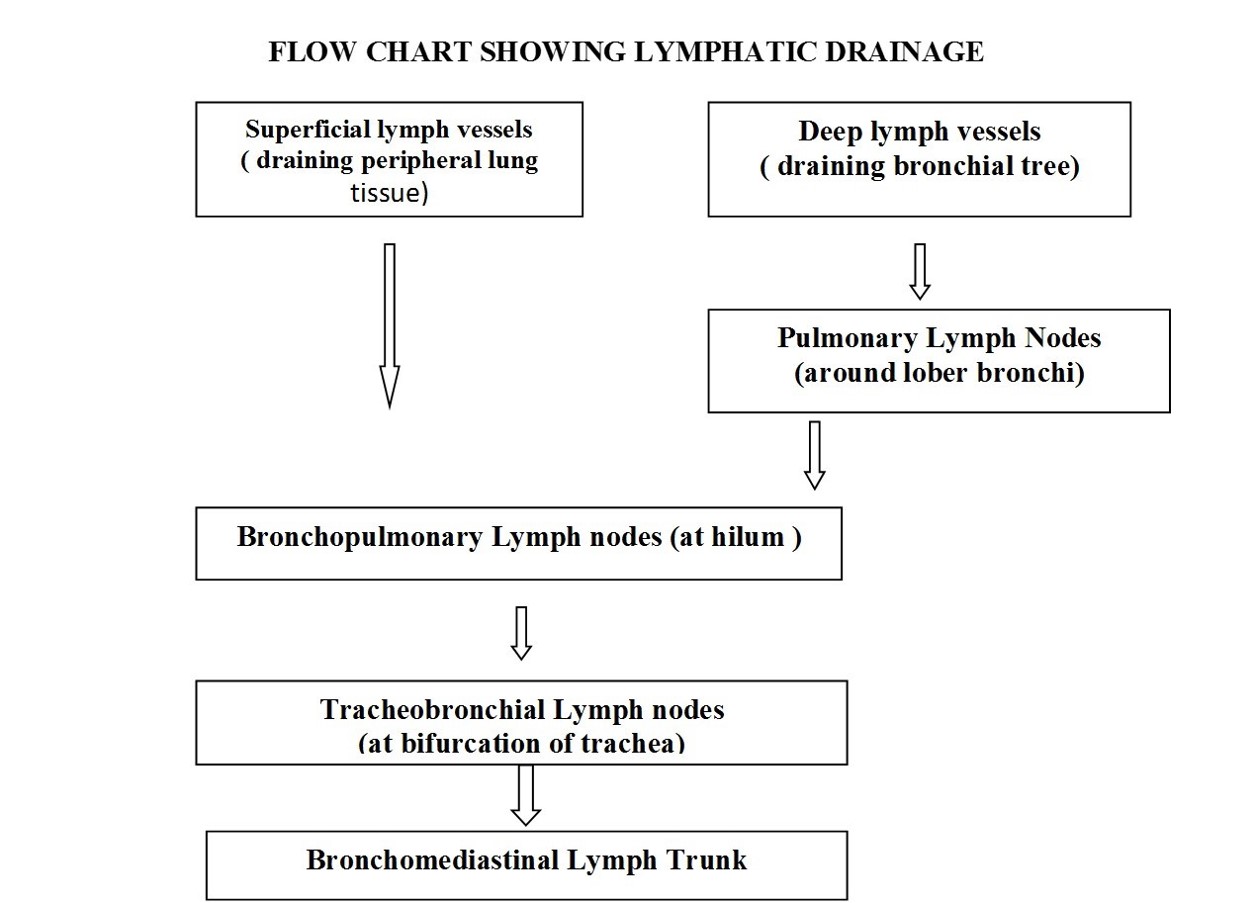

best site to learn anatomy
Ma’am literally this is the best site I have ever seen in my first prof year
I can do rapid revision,comple important topics,get to watch lecture videos,it’s just perfect ma’am
But from past 6 months u r not updated anything in ur YouTube channel please I request u to upload all topics in ur channel
Thanking you..☺️
Thanks a lot.